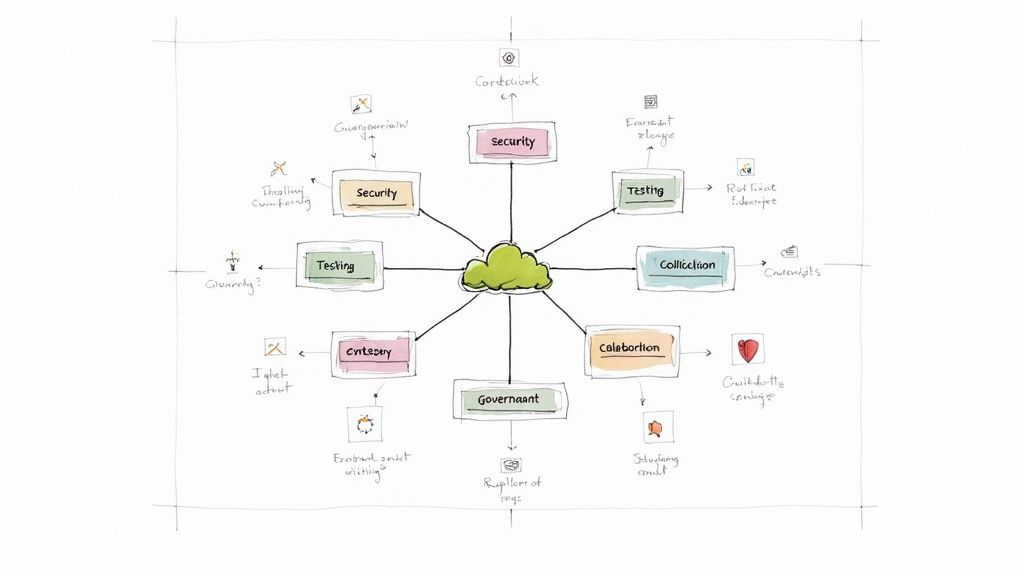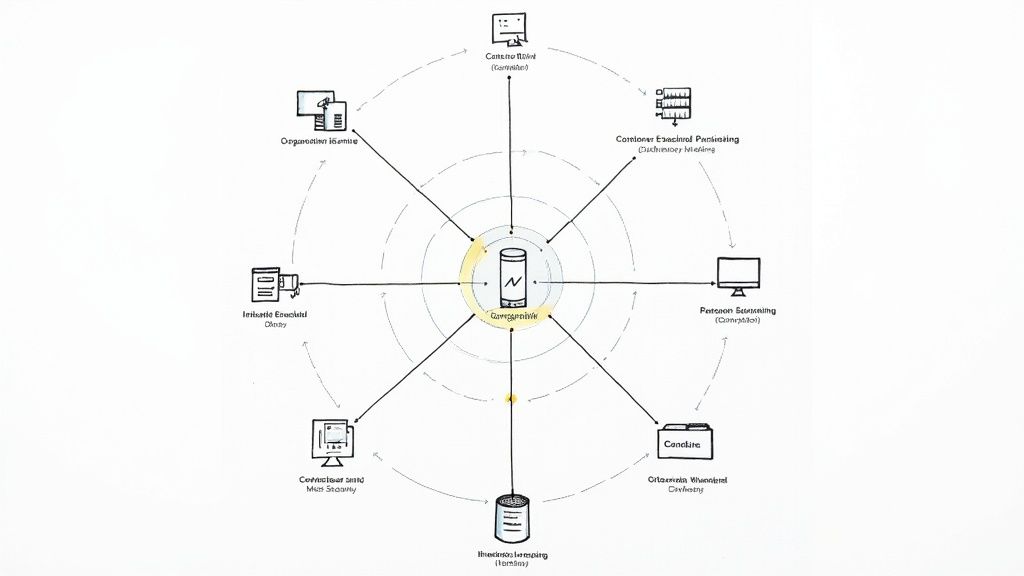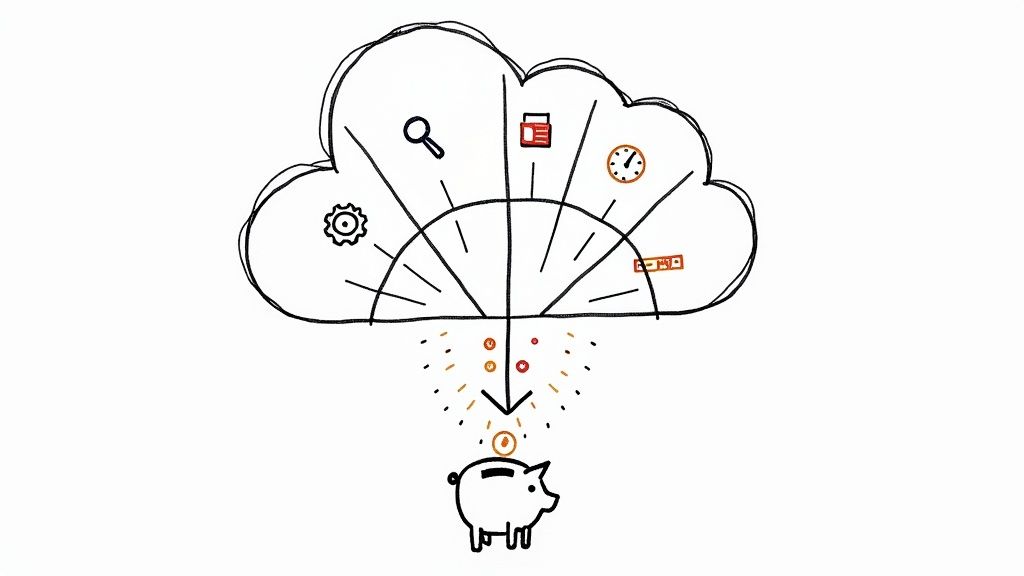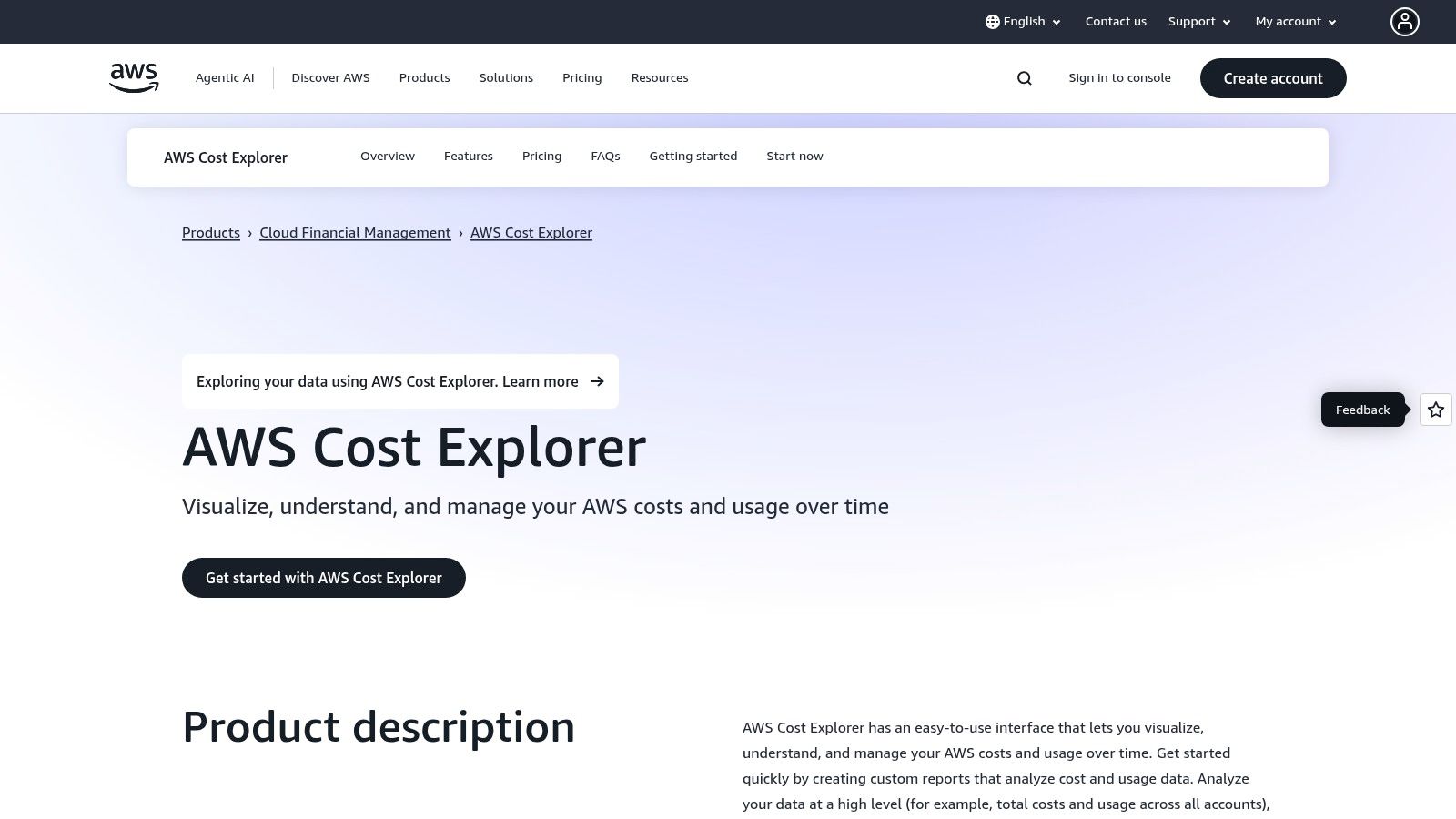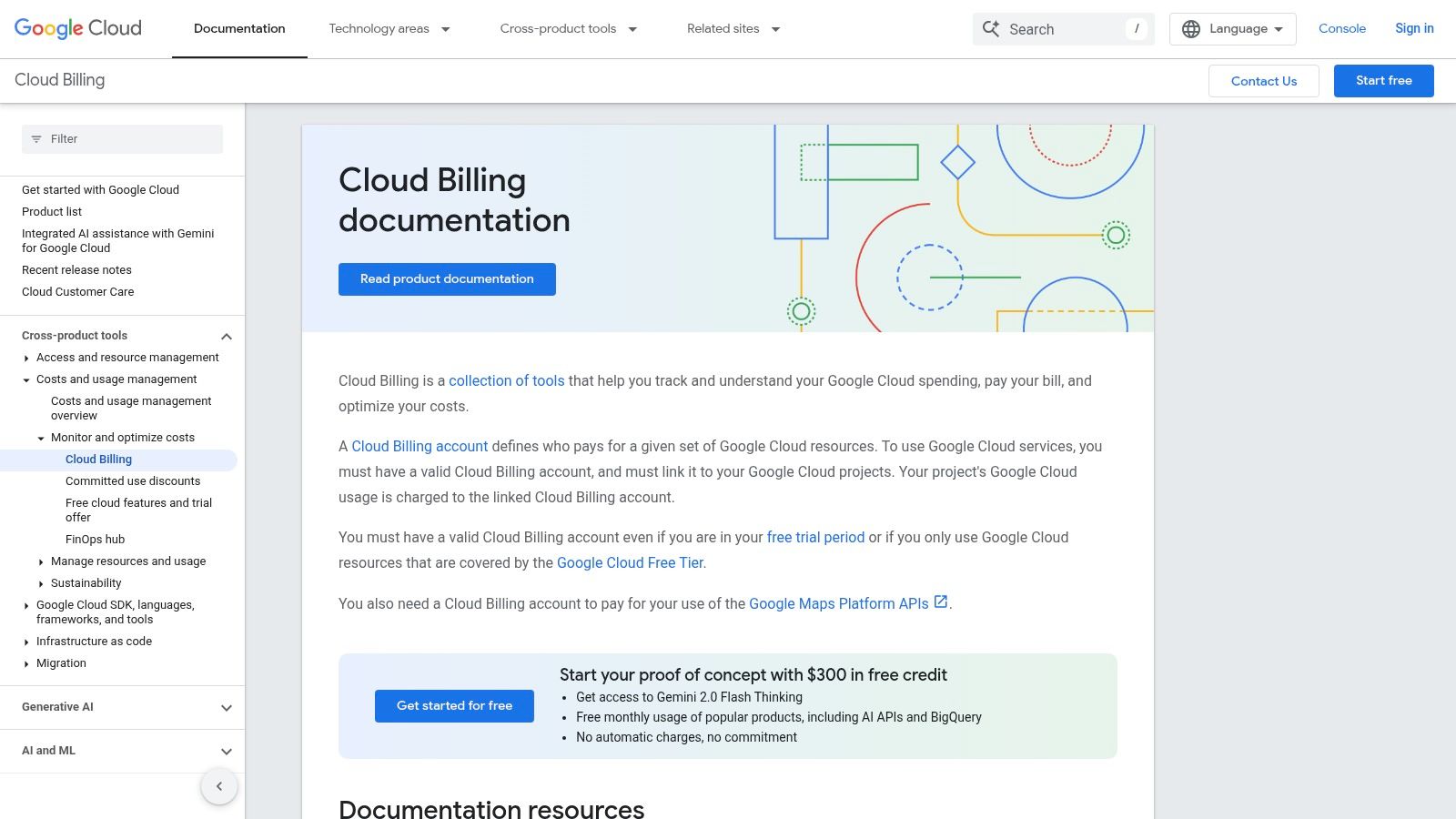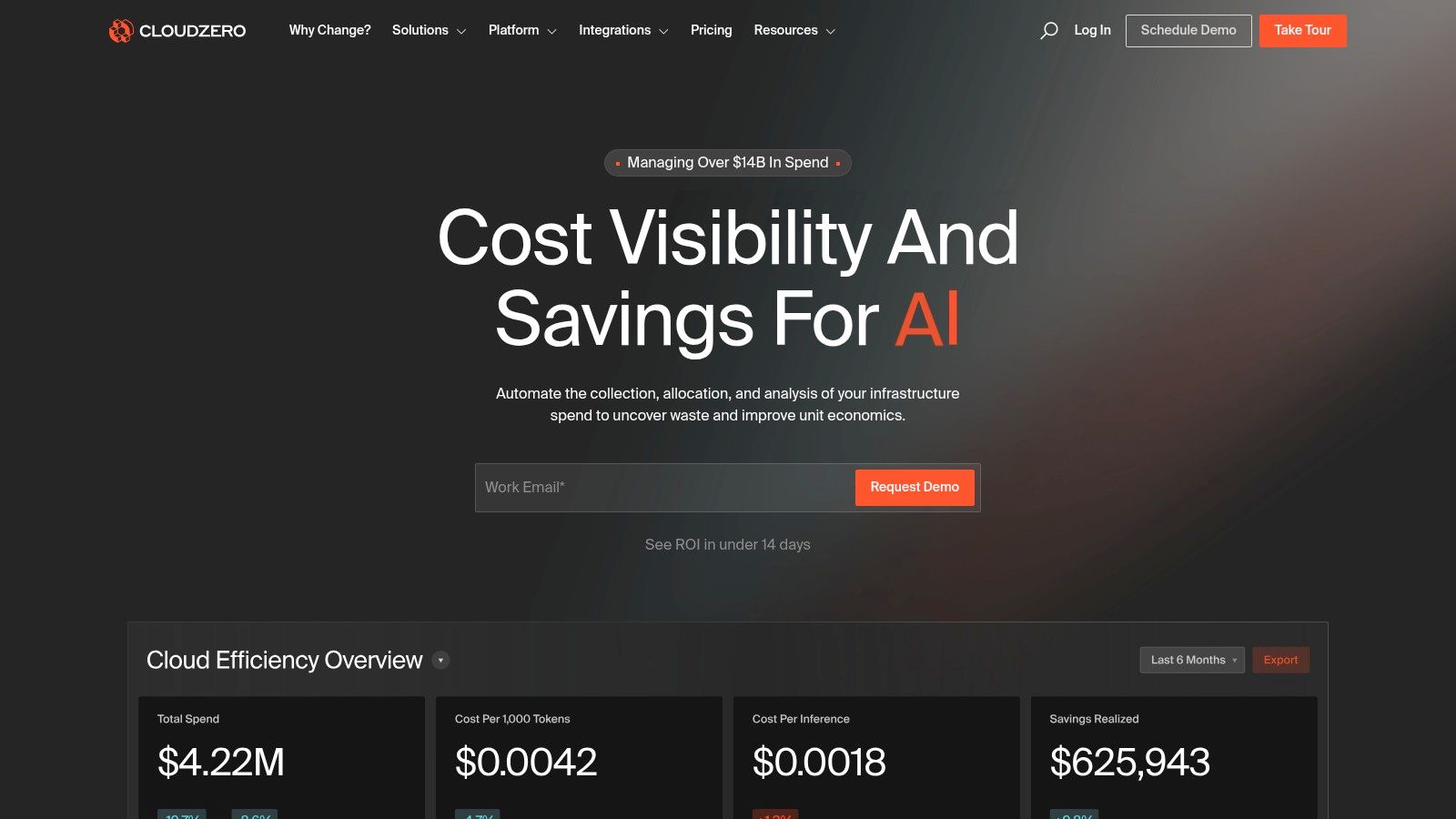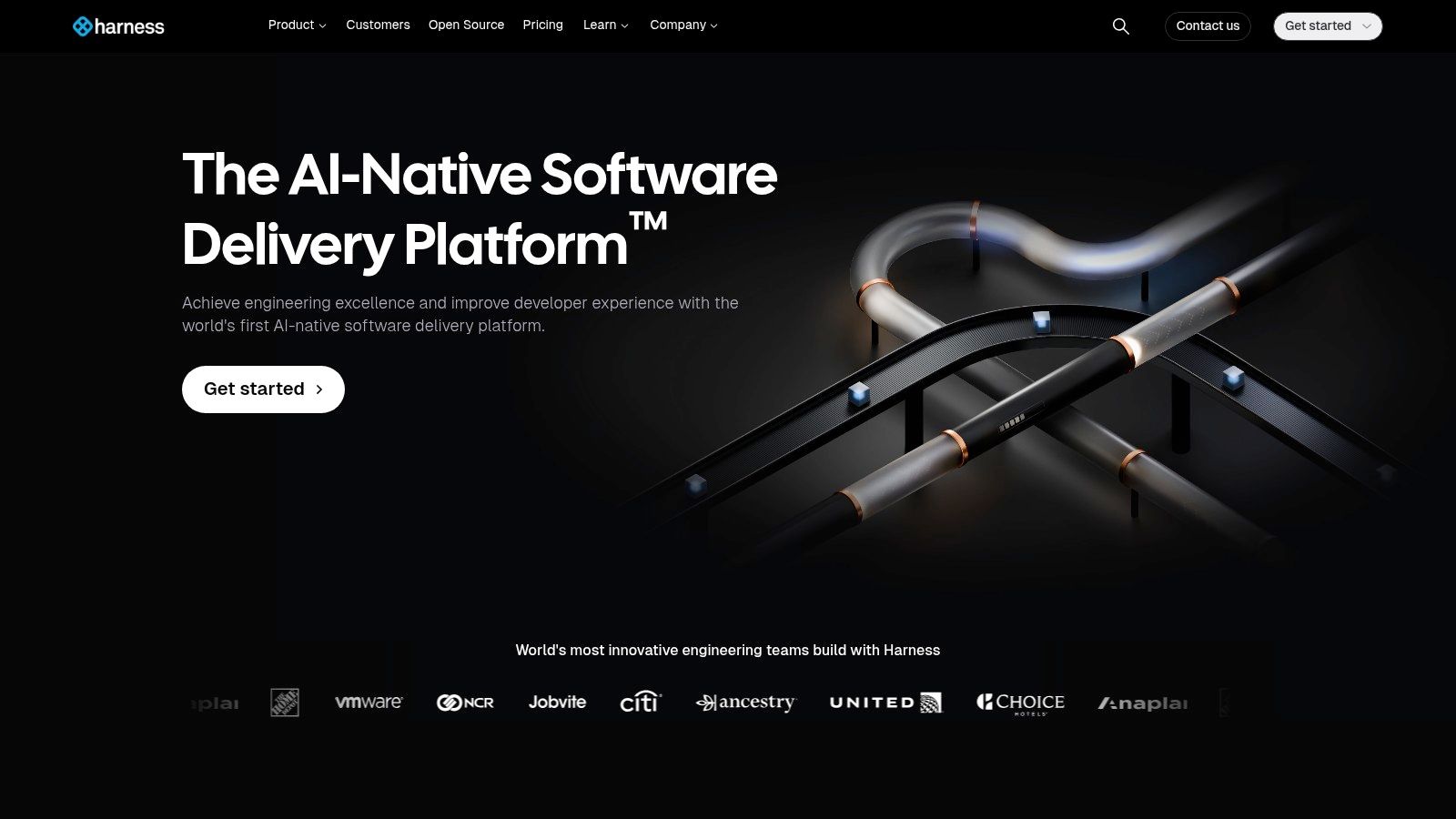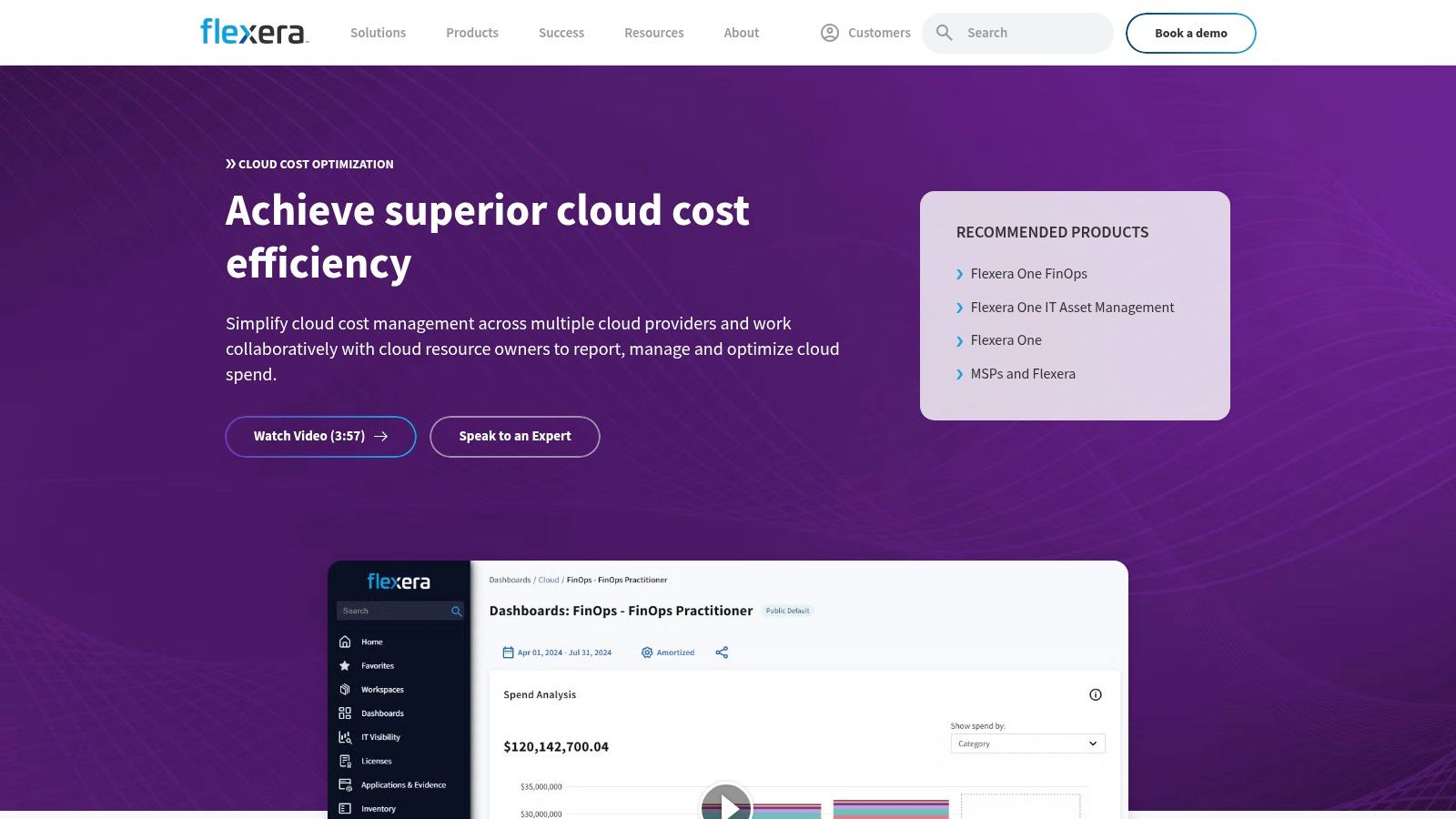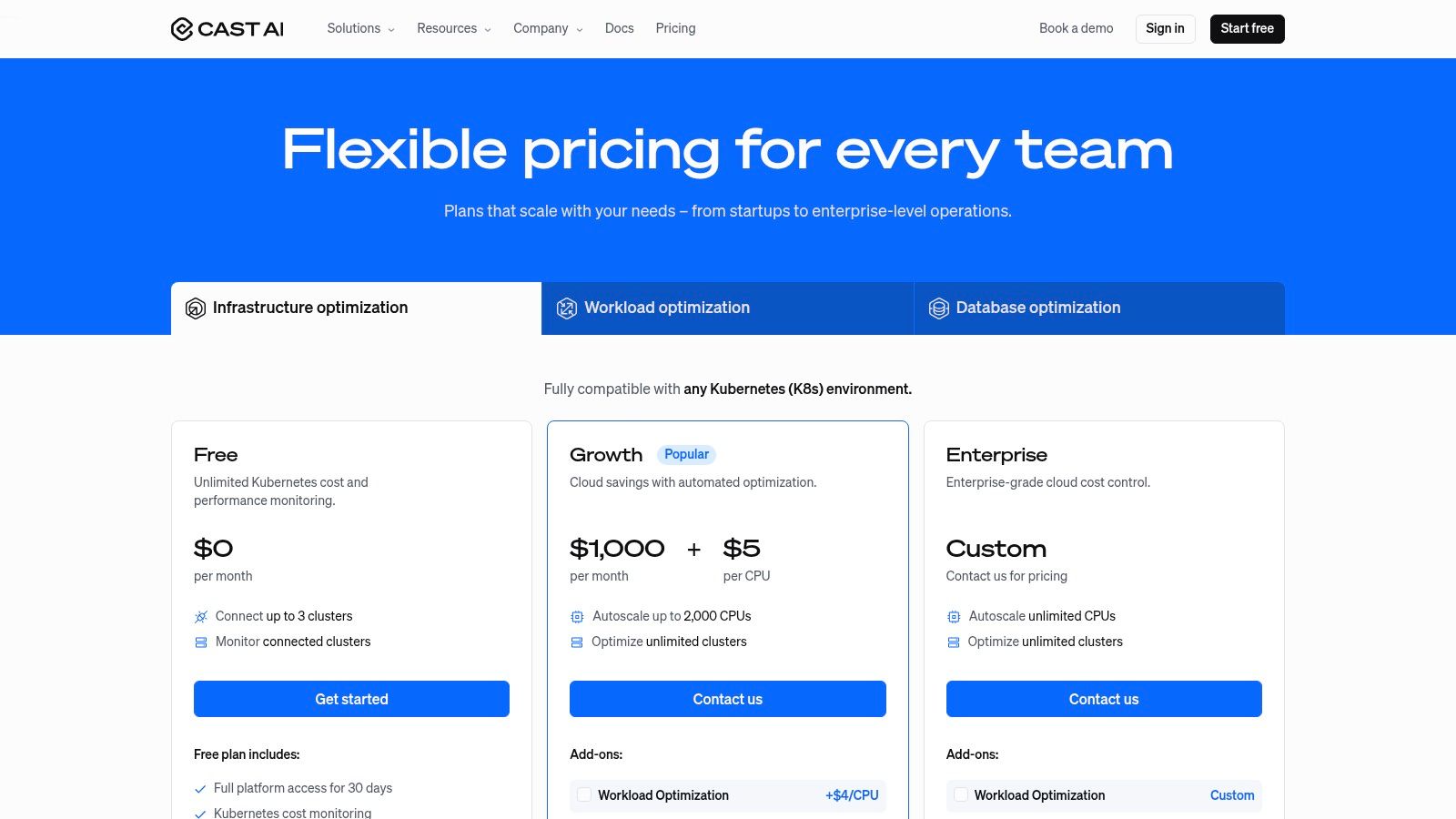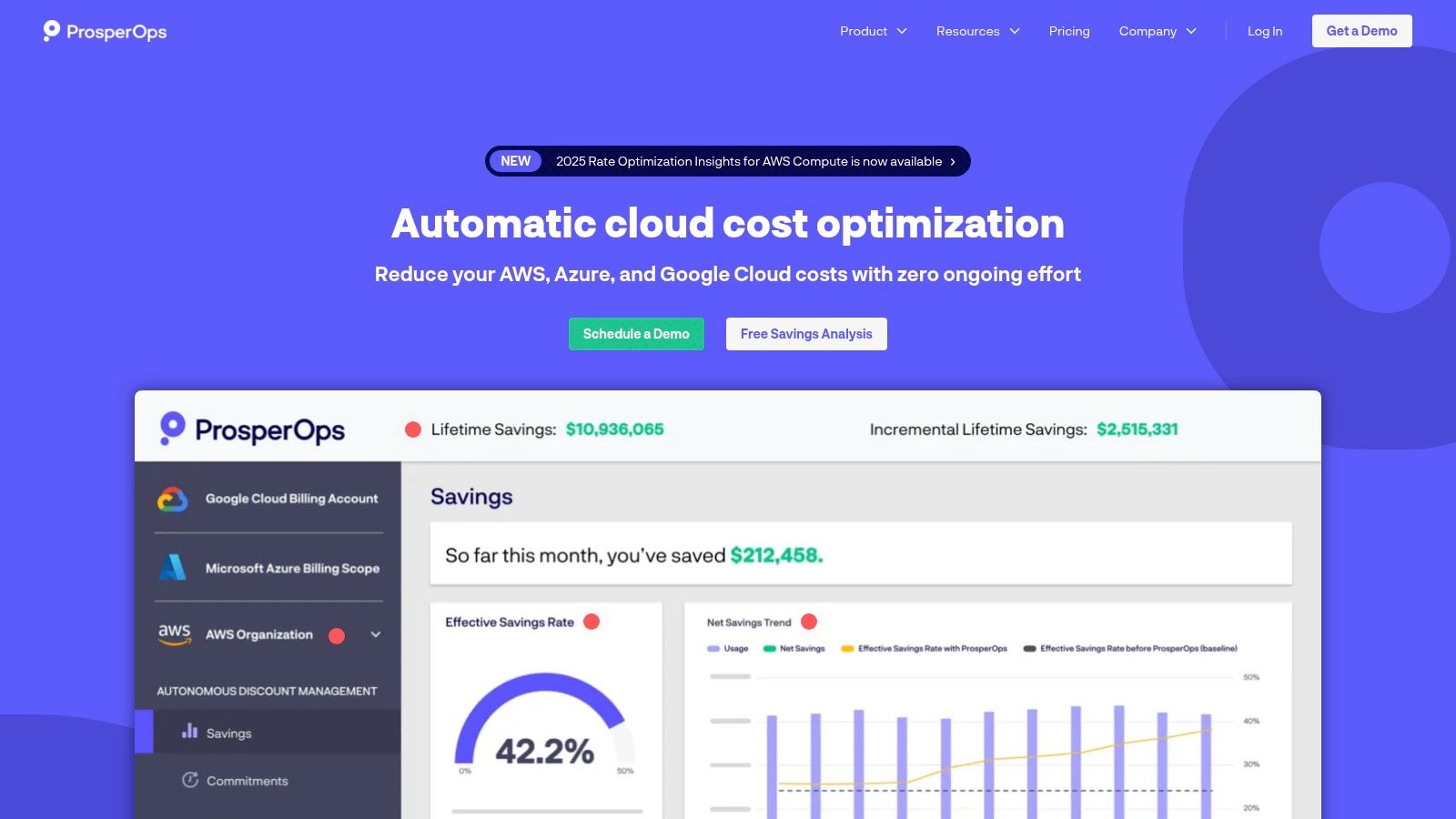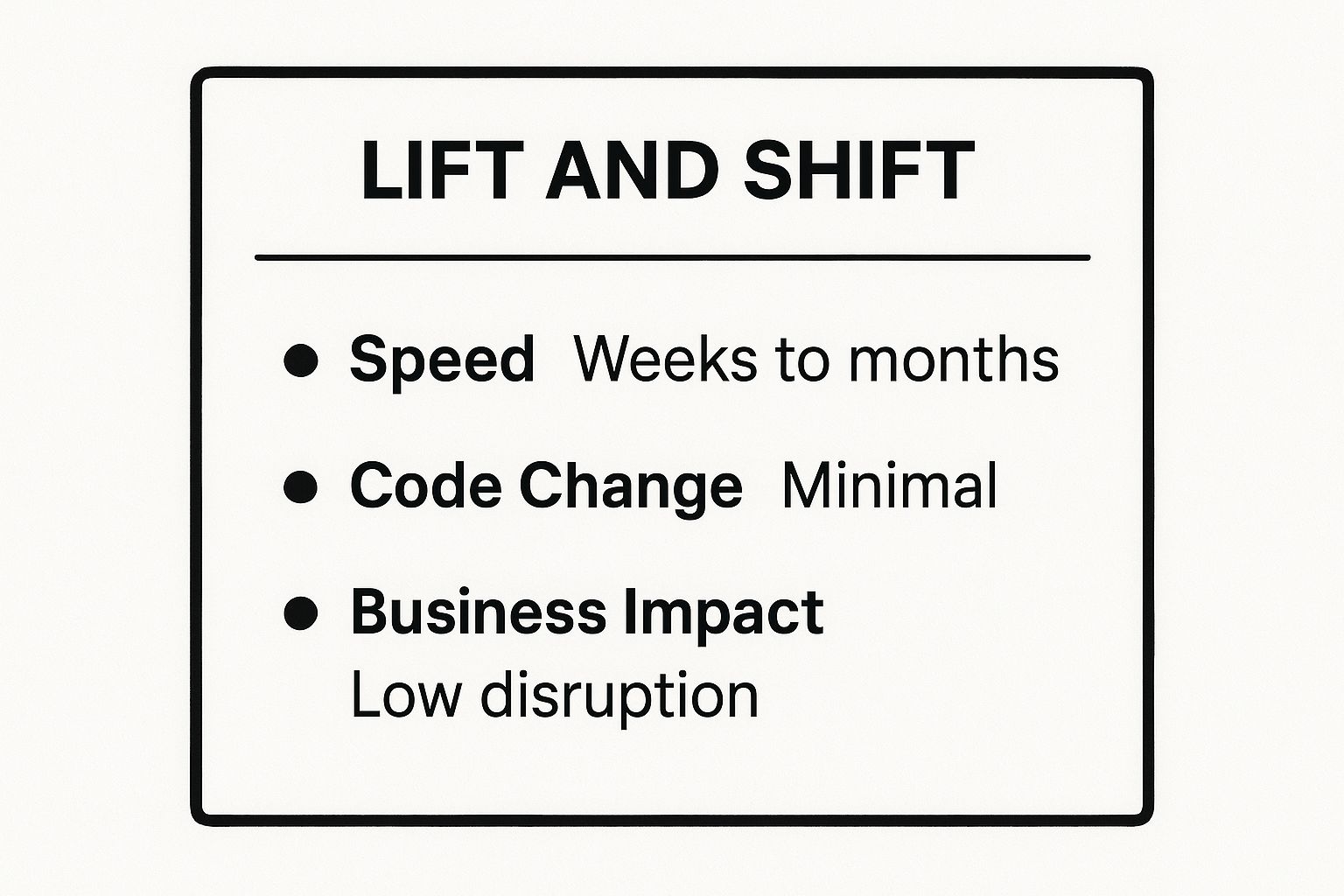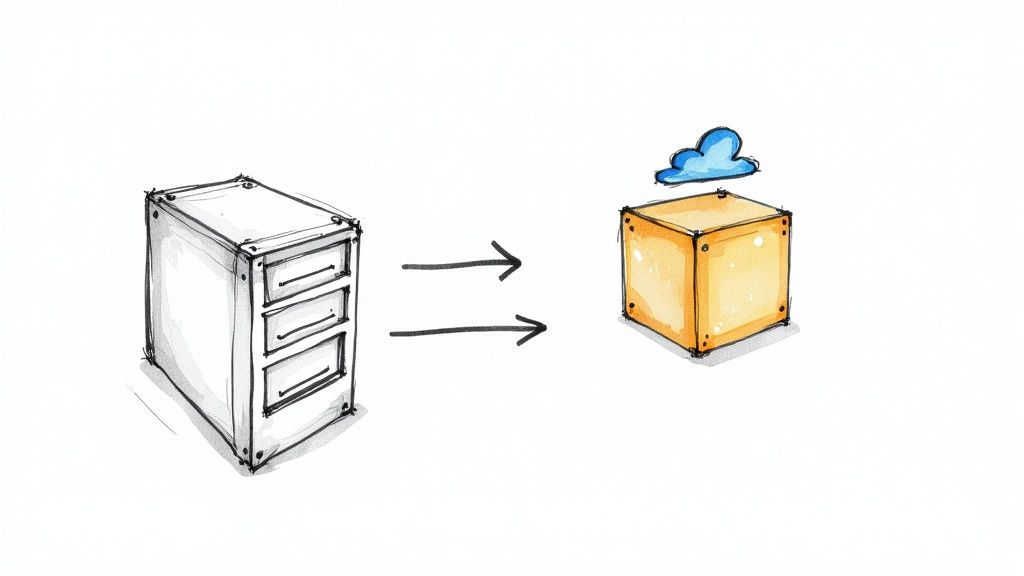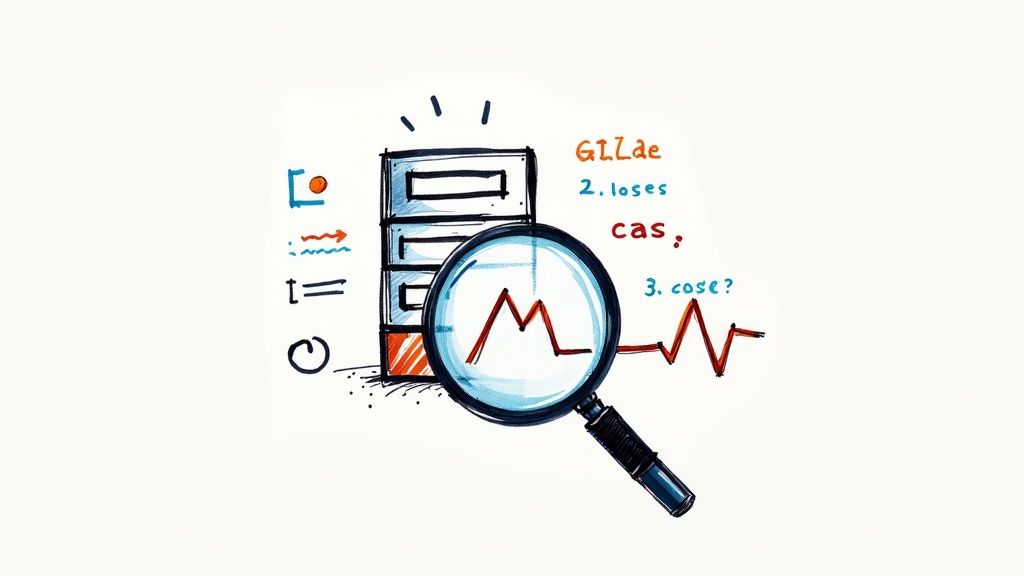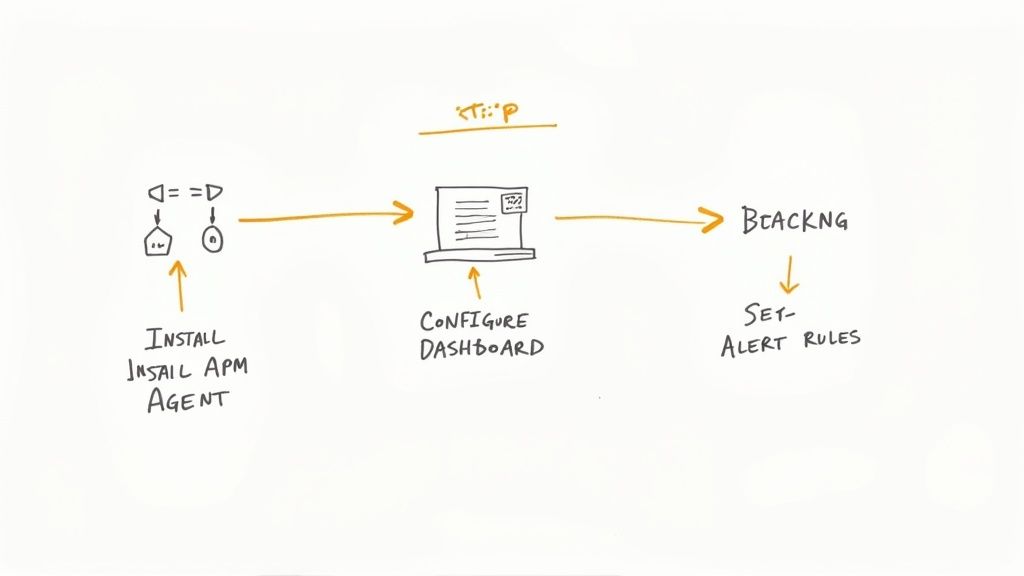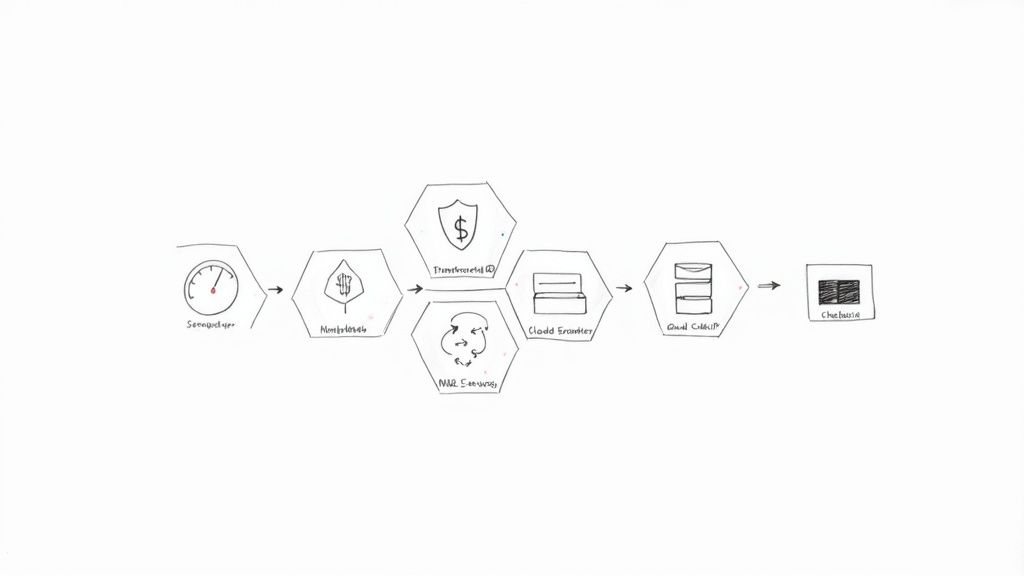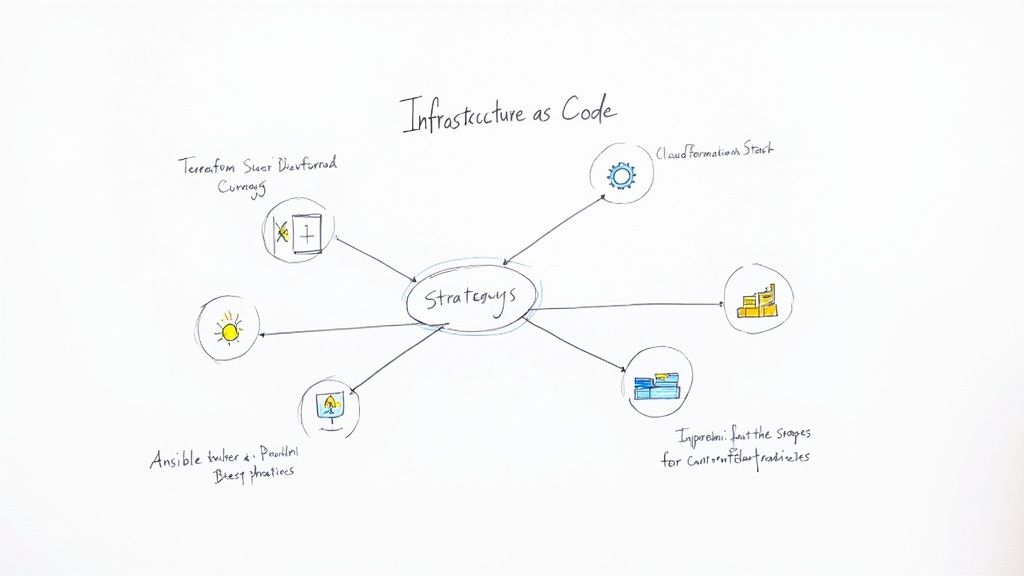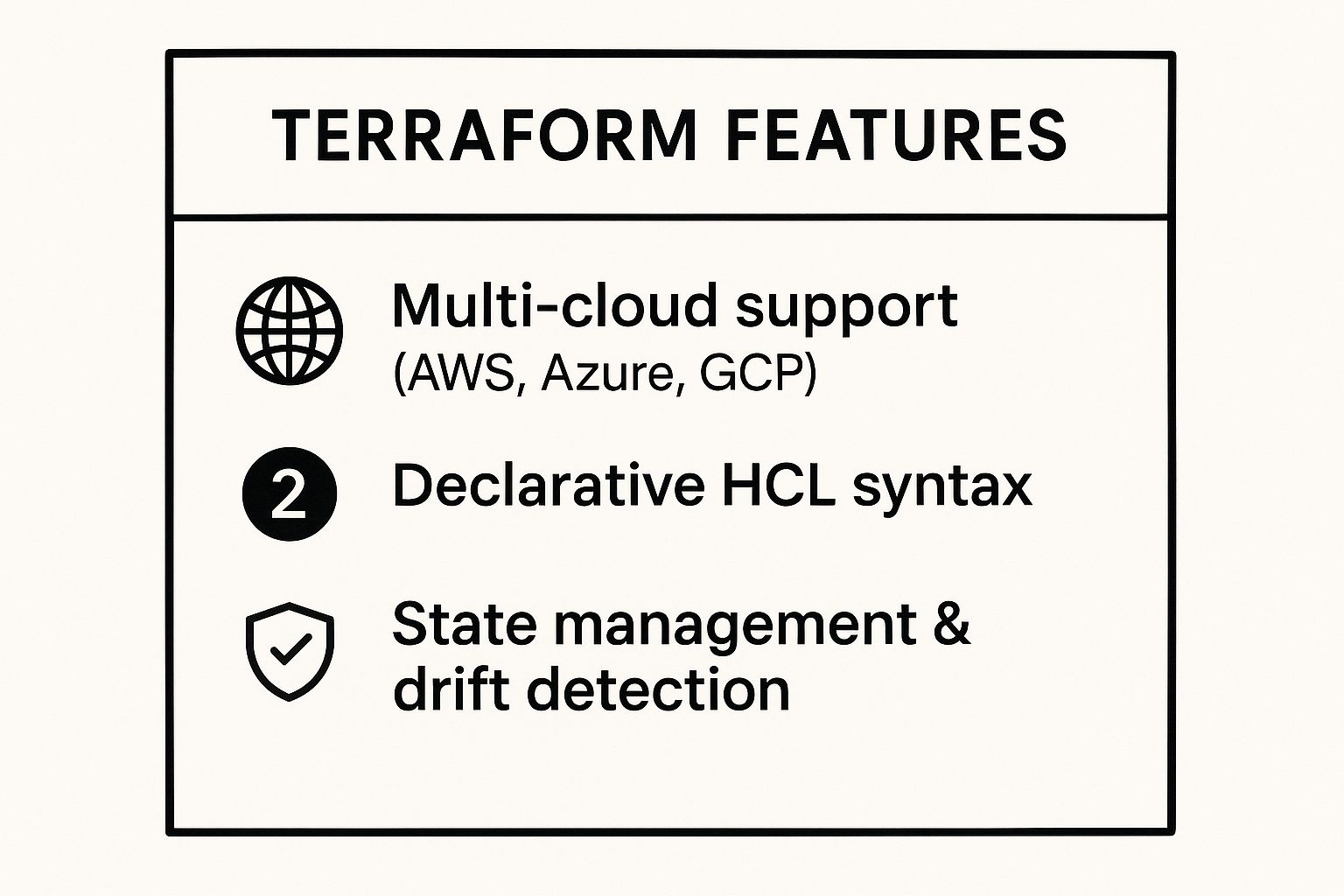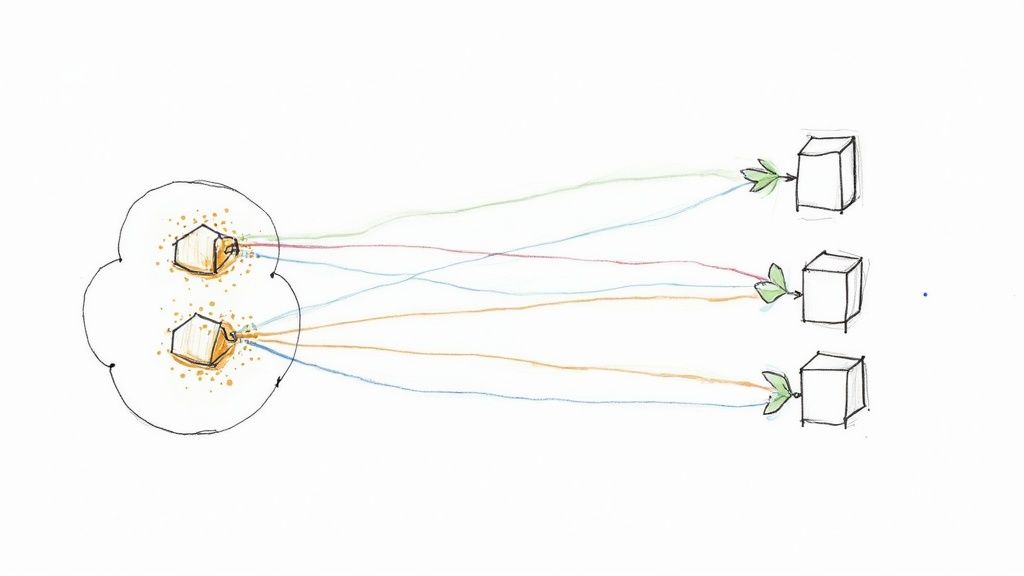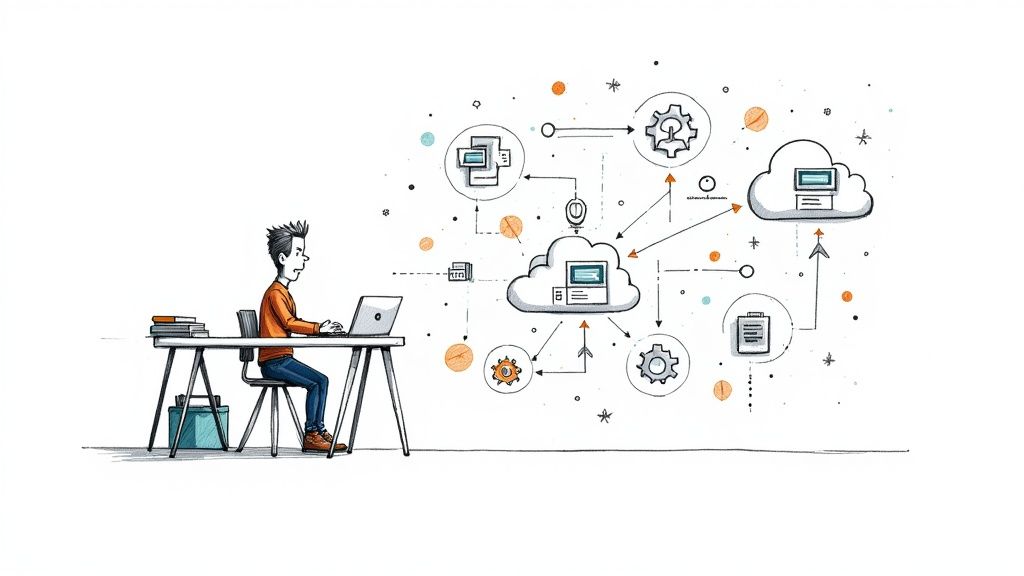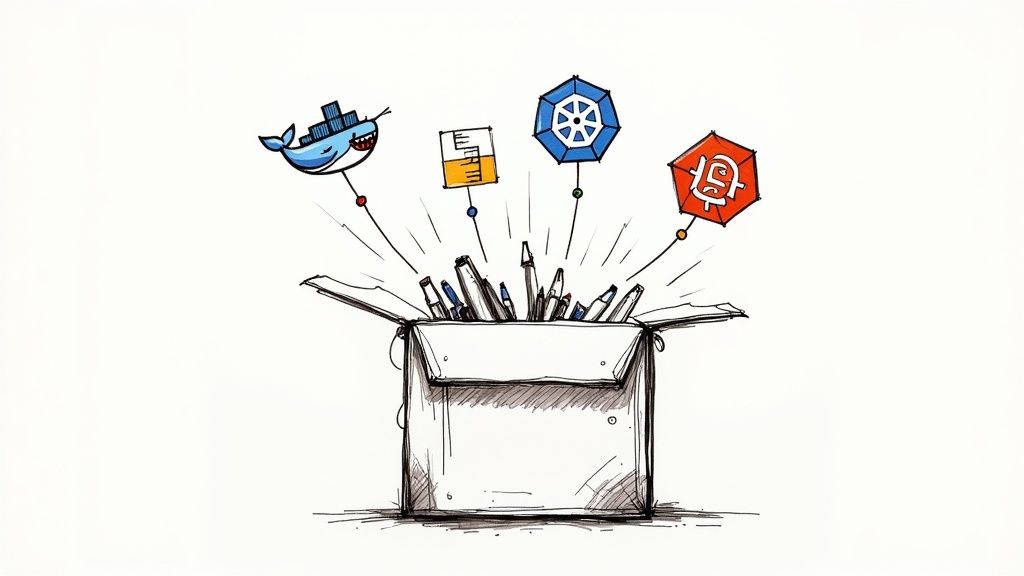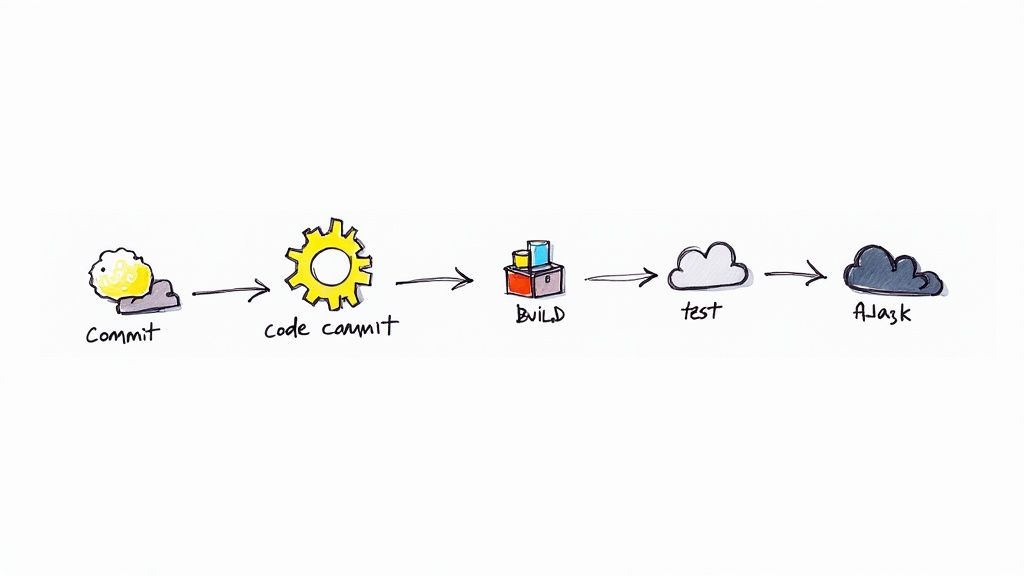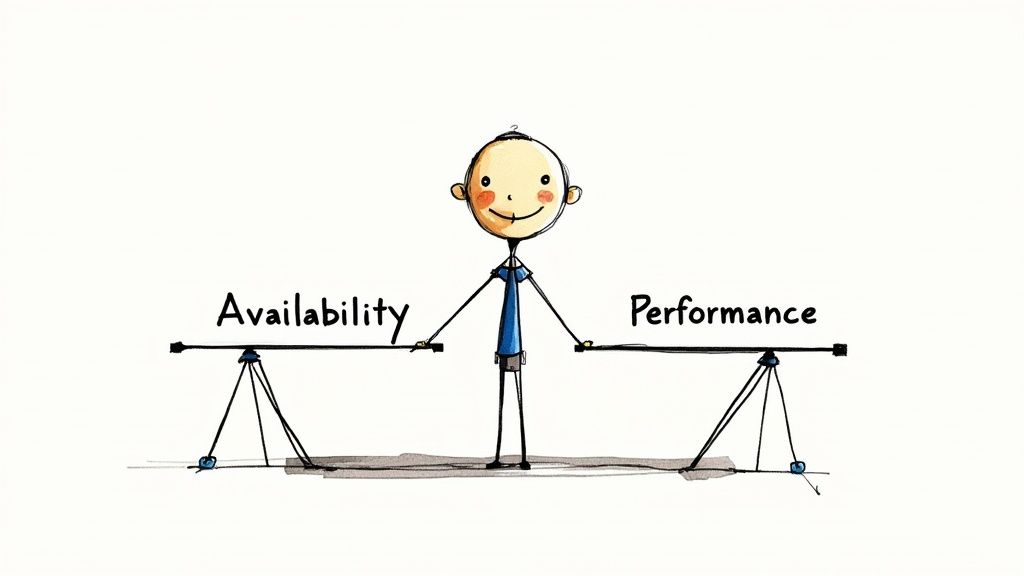Adopting Infrastructure as Code (IaC) is more than just scripting; it's a fundamental shift in how we build, deploy, and manage modern systems. By defining infrastructure in declarative configuration files, teams can automate provisioning, eliminate configuration drift, and create reproducible environments. But without a solid foundation of best practices, IaC can introduce its own brand of complexity, risk, and technical debt, turning a powerful enabler into a source of friction. The difference between a high-performing IaC strategy and a brittle one often comes down to the disciplined application of proven principles.
This guide moves beyond the basics, providing a technical deep-dive into the nine most critical infrastructure as code best practices that elite DevOps teams use to achieve velocity, reliability, and security at scale. Your Infrastructure as Code strategy should be built upon a solid understanding of fundamental SDLC best practices, as treating your infrastructure definitions with the same rigor as your application code is paramount. We will explore specific, actionable techniques that address the entire lifecycle of your infrastructure, from initial commit to production deployment and beyond.
Whether you're refining your Terraform workflows, automating Kubernetes deployments with Helm, or managing cloud resources with Pulumi, these strategies will provide the blueprint you need. You will learn how to:
- Structure your code for modularity and reuse.
- Implement robust testing and validation pipelines.
- Manage state and secrets securely and effectively.
- Integrate IaC into a seamless CI/CD workflow.
This isn't a theoretical overview. It's a practical playbook for building robust, maintainable, and highly automated cloud environments that can scale with your organization's demands. Let’s dive into the core practices that separate the successful from the struggling.
1. Version Control Everything: Treat Infrastructure as a First-Class Citizen
The foundational principle of Infrastructure as Code (IaC) is to manage and provision infrastructure through machine-readable definition files, rather than physical hardware configuration or interactive configuration tools. This first and most crucial of all infrastructure as code best practices is to treat those definition files with the same discipline and rigor as application source code. This begins by committing every infrastructure artifact to a version control system (VCS) like Git.
Placing your Terraform configurations, CloudFormation templates, Ansible playbooks, or Kubernetes manifests in a Git repository establishes a single source of truth. This creates an immutable, auditable log of every single change made to your environment. You can pinpoint exactly who changed what, when they changed it, and why, transforming infrastructure management from an opaque, manual process into a transparent engineering discipline.
Why This Is a Foundational Practice
Version control is the bedrock upon which other advanced practices like CI/CD, GitOps, and automated testing are built. Without it, collaboration becomes chaotic, rollbacks are manual and risky, and disaster recovery is a matter of guesswork. It enables parallel development using branching strategies, ensures quality through peer reviews via pull requests, and provides the stability needed to build complex systems.
For example, a DevOps team can use a dedicated Git repository for their Terraform modules, enforcing a rule that no change is merged to the main branch without at least one approval. This simple workflow prevents configuration drift and unilateral changes that could cause an outage.
Actionable Implementation Tips
To effectively implement version control for your infrastructure, follow these technical guidelines:
- Adopt a Branching Strategy: Use a model like GitFlow or a simpler trunk-based development flow. Create feature branches for new infrastructure (e.g.,
feature/add-redis-cache) and use pull/merge requests to review, test, and approve changes before integrating them. - Write Atomic, Descriptive Commits: A commit message like
feat(vpc): add egress-only internet gateway for private subnetsis far more valuable thanupdated network stuff. This provides clear, searchable history. - Use Git Tags for Releases: Tag commits that represent a stable, deployable version of your infrastructure (e.g.,
v1.2.0). This helps align infrastructure versions with specific application releases. - Leverage Pre-Commit Hooks: Integrate tools like
tfsecfor security scanning,tflintfor linting, andterraform fmtfor formatting. These hooks run automatically before a commit is created, catching errors and enforcing standards early.
2. Embrace Immutable Infrastructure: Eliminate Configuration Drift
Immutable infrastructure is a powerful paradigm where servers and other infrastructure components are never modified after they are deployed. Instead of logging in to patch a running server or reconfigure an application, you build a completely new version of that component, deploy it, and then terminate the old one. This approach, another critical infrastructure as code best practice, treats infrastructure components as ephemeral, replaceable artifacts.
By adopting this model, you fundamentally eliminate configuration drift, the slow, untracked accumulation of changes that makes environments inconsistent and unpredictable. Every deployment starts from a known, version-controlled state, ensuring that your staging environment is an exact replica of production, which drastically simplifies debugging and testing.

Why This Is a Foundational Practice
Immutability turns deployments and rollbacks into simple, low-risk atomic operations. An update is just a new set of resources, and a rollback is as easy as deploying the previous version. This practice, popularized by companies like Netflix and foundational to containerization with Docker and Kubernetes, brings unprecedented predictability and reliability to infrastructure management. It moves teams away from complex, error-prone "in-place" updates toward a more declarative, idempotent operational model.
For instance, a team using Kubernetes doesn't ssh into a running container to apply a patch. Instead, they build a new container image with the patch, update the Deployment manifest to reference the new image tag, and let Kubernetes manage a rolling update, safely replacing old Pods with new ones.
Actionable Implementation Tips
To effectively adopt an immutable infrastructure model, focus on creating and managing deployment artifacts:
- Package Applications as Immutable Units: Use tools like Packer to build versioned Amazon Machine Images (AMIs) or create container images with Docker. These artifacts should contain the application and all its dependencies, ensuring a self-contained, ready-to-run unit.
- Implement Blue-Green or Canary Deployments: Leverage these advanced deployment strategies to safely transition traffic from the old infrastructure version to the new one. This allows for zero-downtime updates and provides an immediate rollback path if issues are detected.
- Decouple State from Compute: Stateful data (like databases, user uploads, or session logs) must be stored externally on managed services like Amazon RDS, S3, or ElastiCache. This allows your compute instances or containers to be terminated and replaced without data loss.
- Automate Artifact Promotion: Create a CI/CD pipeline that automatically builds, tests, and validates your immutable images. A successful build should result in a versioned, tagged artifact that is then promoted through different environments (dev, staging, prod).
3. Strive for Environment Parity: Eliminate the "It Works on My Machine" Problem
A classic source of deployment failures and bugs is the subtle-yet-critical divergence between development, staging, and production environments. Environment parity, a core tenet of modern DevOps and one of the most impactful infrastructure as code best practices, directly addresses this by ensuring that all environments are as identical as possible. The goal is to provision every environment from the same IaC templates, with the only differences being configuration parameters like resource sizes, secrets, and domain names.
This approach, popularized by frameworks like the Twelve-Factor App methodology, minimizes surprises during deployment. When your staging environment mirrors production's architecture, network topology, and service integrations, you can be highly confident that code validated in staging will behave predictably in production. IaC is the key enabler, turning the complex task of replicating environments into a repeatable, automated process.
Why This Is a Foundational Practice
Environment parity transforms your pre-production environments from loose approximations into high-fidelity simulators of production. This drastically reduces the risk of environment-specific bugs that are costly and difficult to debug post-release. By codifying the entire environment, you eliminate configuration drift caused by manual "hotfixes" or undocumented changes, ensuring that every deployment target is a known, consistent state.
For instance, a team using Terraform can manage multiple AWS accounts (dev, staging, prod) using the same set of modules. The production environment might be provisioned with a t3.large RDS instance, while staging uses a t3.medium and dev a t3.small. While the instance sizes differ for cost-saving, the networking rules, IAM policies, and database configurations remain identical, preserving architectural integrity across the pipeline.
Actionable Implementation Tips
To effectively achieve and maintain environment parity, apply these technical strategies:
- Use Variables and Parameter Files: Externalize all environment-specific configurations. Use Terraform's
.tfvarsfiles, CloudFormation parameter files, or Helmvalues.yamlfiles for each environment. The core IaC logic should remain unchanged. - Leverage IaC Workspaces or Stacks: Tools like Terraform Workspaces or Pulumi Stacks are designed to manage multiple instances of the same infrastructure configuration. Each workspace or stack maps to an environment (e.g.,
dev,stg,prod) and manages its own separate state file. - Automate Environment Provisioning: Integrate your IaC toolchain into your CI/CD pipeline to create and destroy ephemeral environments for pull requests. This allows for testing changes in a perfect, isolated replica of production before merging.
- Keep Topologies Identical: While resource scaling (CPU, memory) can differ to manage costs, the architectural topology should not. If production has a load balancer, a web fleet, and a database, your staging and development environments should too, even if the "fleet" is just a single small instance.
4. Infrastructure Testing and Validation
Just as application code requires rigorous testing before being deployed to production, so does your infrastructure code. One of the most critical infrastructure as code best practices is to establish a comprehensive testing and validation strategy. This involves creating automated checks that run against your IaC definitions to catch syntax errors, logical flaws, security vulnerabilities, and compliance violations before they impact your live environment.

Treating infrastructure code as a testable artifact fundamentally shifts the operational mindset from reactive fire-fighting to proactive quality assurance. Instead of discovering a misconfigured security group after a breach, you can identify the issue during a CI pipeline run. This practice builds confidence in your deployments, accelerates release velocity, and significantly reduces the risk of costly, service-impacting errors.
Why This Is a Foundational Practice
Without automated testing, every infrastructure change is a high-stakes gamble. Manual reviews are prone to human error and cannot scale effectively as infrastructure complexity grows. A robust testing pyramid for IaC, including static analysis, unit, and integration tests, provides a safety net that ensures infrastructure is deployed correctly, securely, and consistently every time. This discipline is essential for achieving true continuous delivery and maintaining operational stability.
For example, a platform engineering team can use Terratest to write Go-based integration tests for their Terraform modules. A test could be designed to spin up an AWS S3 bucket using the module, verify that server-side encryption is enabled by default, and then tear down the resource. This automated check guarantees that all buckets provisioned by this module adhere to the company's security policy.
Actionable Implementation Tips
To effectively integrate testing and validation into your IaC workflow, follow these technical guidelines:
- Start with Static Analysis and Linting: Integrate tools like
tflintorcfn-lintdirectly into your CI pipeline and pre-commit hooks. These tools perform fast checks for syntax errors, deprecated resources, and common misconfigurations without deploying any infrastructure. - Implement Policy-as-Code for Compliance: Use frameworks like Open Policy Agent (OPA) with Conftest or Sentinel by HashiCorp. This allows you to define and enforce specific governance rules, such as "all EBS volumes must be encrypted" or "EC2 instances cannot use the
0.0.0.0/0security group ingress rule." - Use Ephemeral Test Environments: For integration and end-to-end tests, spin up short-lived environments that mirror production. Tools like Ansible Molecule for role testing or Terratest for Terraform are designed to provision infrastructure, run validation checks, and then automatically destroy the resources to control costs.
- Integrate Testing into CI/CD Pipelines: Embed your testing stages directly into your CI/CD pipeline. A typical pipeline should follow a sequence of lint -> validate -> plan -> test (in a temporary environment) -> deploy. This ensures that no untested code reaches your production environment.
5. Modular and Reusable Code
As infrastructure environments grow in complexity, managing monolithic configuration files becomes untenable. Adopting a modular approach is one of the most impactful infrastructure as code best practices for achieving scale and maintainability. This practice involves structuring your code into smaller, reusable, and composable modules that encapsulate specific functionality, like a VPC network, a database instance, or a Kubernetes cluster configuration.
By breaking down your infrastructure into logical, self-contained units, you transform your codebase from a sprawling script into a clean, well-organized library of building blocks. A team can define a standard module for deploying an application's backend services, which can then be instantiated consistently across development, staging, and production environments with different input parameters. This greatly reduces duplication, simplifies maintenance, and enforces organizational standards.
Why This Is a Foundational Practice
Modular code is the key to managing complexity and ensuring consistency at scale. It prevents configuration drift by providing standardized, versioned components that teams can trust. Instead of reinventing the wheel for every project, engineers can leverage a catalog of pre-approved modules, accelerating delivery and reducing the likelihood of human error. This pattern is so fundamental that major IaC tools have built entire ecosystems around it, such as the Terraform Registry and Ansible Galaxy.
This approach also simplifies updates and refactoring. If you need to update the logging configuration for all RDS databases, you only need to modify the central RDS module. Once the new module version is published, every project that consumes it can be updated in a controlled, predictable manner.
Actionable Implementation Tips
To effectively create and manage modular infrastructure code, consider these technical guidelines:
- Design for Single Responsibility: Each module should do one thing and do it well. For example, a module for an AWS S3 bucket should only create the bucket and its associated policies, not the IAM roles that access it.
- Use Semantic Versioning: Tag your modules with versions (e.g.,
v1.2.0) in their Git repository. This allows consuming projects to pin to a specific, stable version, preventing unexpected changes from breaking their deployments. - Provide Clear Documentation and Examples: Every module should have a
README.mdfile that explains its purpose, lists all input variables and outputs, and includes a clear usage example. See these infrastructure as code examples for a practical look at how modules are structured. - Implement Input Validation and Sensible Defaults: Your module should validate incoming variables to catch errors early and provide sane default values wherever possible to make it easier to use. For instance, a security group module could default to denying all ingress traffic.
6. Secrets and Configuration Management: Secure Your Sensitive Data
One of the most critical infrastructure as code best practices is the secure handling of sensitive data. Hardcoding secrets like API keys, database passwords, or private certificates directly into your IaC files is a severe security vulnerability. Once committed to version control, this sensitive information becomes exposed to anyone with repository access and can persist in the Git history even if removed later. Effective secrets management separates sensitive data from your declarative code, injecting it securely only when and where it is needed.
This practice involves using dedicated secret management tools to store, control, and audit access to tokens, passwords, and other credentials. Your infrastructure code then references these secrets dynamically during runtime, rather than storing them in plain text. This approach not only prevents credential leakage but also centralizes secrets management, making rotation and auditing a streamlined, policy-driven process. It is a non-negotiable step for building secure, compliant, and production-ready infrastructure.
Why This Is a Foundational Practice
Failing to properly manage secrets undermines the security of your entire stack. A leaked credential can provide an attacker with a direct entry point into your cloud environment, databases, or third-party services. Centralized secret stores like HashiCorp Vault, AWS Secrets Manager, or Azure Key Vault provide a secure, encrypted, and access-controlled source of truth for all sensitive configuration. This decouples the lifecycle of your secrets from your code, enabling automated rotation and fine-grained access policies without requiring code changes.
For instance, a Kubernetes deployment manifest can be configured to pull a database password from Azure Key Vault at pod startup. The manifest itself contains only a reference to the secret, not the value. This ensures developers can manage deployments without ever needing to see or handle the production password, drastically reducing the attack surface. For deeper insights into securing your CI/CD pipeline, you can learn more about comprehensive DevOps security best practices.
Actionable Implementation Tips
To implement robust secrets management in your IaC workflows, follow these technical guidelines:
- Use a Dedicated Secret Store: Integrate your IaC tools with a specialized service. Use the AWS Secrets Manager data source in Terraform, the
secrets-store.csi.k8s.iodriver in Kubernetes, or native integrations with Azure Key Vault in ARM templates. - Implement Least-Privilege Access: Configure IAM roles or policies that grant your CI/CD pipeline or deployment compute instances the minimum permissions required to retrieve only the specific secrets they need for a task.
- Automate Secret Rotation: Leverage the built-in rotation capabilities of your secrets manager. For example, configure AWS Secrets Manager to automatically rotate RDS database credentials every 30 days, ensuring credentials have a limited lifetime.
- Scan for Secrets in CI/CD: Integrate automated secret scanning tools like
gitleaksortruffleHoginto your pre-commit hooks and CI pipeline. This acts as a safety net to catch any credentials that are accidentally hardcoded before they are merged.
7. State Management and Backend Configuration
Most modern IaC tools, like Terraform and Pulumi, rely on a state file to map real-world resources to your configuration. This state file tracks metadata about your managed infrastructure, acting as a crucial bridge between your code and the provisioned environment. Another essential entry in our list of infrastructure as code best practices is to actively manage this state, moving it away from your local machine and into a secure, centralized location.
Using a remote backend is the standard solution for state management in any collaborative setting. A remote backend is a shared storage service (like an AWS S3 bucket, Azure Blob Storage, or Google Cloud Storage) configured to store the state file. This ensures that every team member operates with the same, most up-to-date view of the infrastructure, preventing conflicts and data loss.
Why This Is a Foundational Practice
Local state management is a recipe for disaster in team environments. If a state file is stored only on a developer's laptop, it can be accidentally deleted, become out of sync, or lead to multiple engineers unknowingly making conflicting changes to the same resources, causing corruption. Proper state management with remote backends and locking mechanisms is non-negotiable for collaborative, production-grade IaC.
For instance, a team using Terraform can configure an AWS S3 backend with a DynamoDB table for state locking. When one engineer runs terraform apply, a lock is placed in the DynamoDB table. If another team member attempts to run an apply at the same time, the operation will fail until the lock is released, preventing "race conditions" that could corrupt the state and the infrastructure itself.
Actionable Implementation Tips
To implement robust state management, follow these technical guidelines:
- Always Use Remote Backends: For any project involving more than one person, configure a remote backend from day one. Do not commit state files directly to your version control system; add
*.tfstateand*.tfstate.backupto your.gitignorefile. - Enable State Locking: Choose a backend that supports state locking, such as AWS S3 with DynamoDB, Azure Blob Storage with native locking, or HashiCorp Consul. This is your primary defense against concurrent state modifications.
- Encrypt State at Rest: State files contain potentially sensitive information about your infrastructure. Ensure the remote backend is configured to encrypt data at rest (e.g., using S3 server-side encryption).
- Logically Organize State Files: Avoid a single, monolithic state file for your entire infrastructure. Instead, break it down by environment, region, or component (e.g.,
prod/us-east-1/vpc/terraform.tfstate). Tools like Terragrunt can help automate this organization.
8. Continuous Integration and Deployment (CI/CD)
Just as application code benefits from automated build and deployment pipelines, your infrastructure code requires the same level of automation and rigor. Implementing CI/CD for IaC is a cornerstone of modern DevOps and one of the most impactful infrastructure as code best practices. It involves creating automated pipelines that validate, test, plan, and apply infrastructure changes whenever code is pushed to your version control system.
By integrating IaC into a CI/CD pipeline, you transform infrastructure management from a manual, error-prone task into a systematic, repeatable, and audited process. This automation ensures every change is consistently vetted against your standards before it reaches production, dramatically reducing the risk of misconfigurations and configuration drift.
Why This Is a Foundational Practice
Automating infrastructure deployments through CI/CD pipelines enforces consistency and provides a clear, controlled path to production. It removes the "it works on my machine" problem by running IaC tools like Terraform or CloudFormation in a standardized, ephemeral environment. This practice codifies your deployment process, making it transparent and easy for new team members to understand and contribute to.
For instance, a GitHub Actions workflow can be configured to automatically run terraform plan on every pull request, posting the output as a comment. This gives reviewers an exact preview of the proposed changes, allowing them to approve or deny the change with full confidence before it is merged and applied to the production environment.
Actionable Implementation Tips
To build robust and secure CI/CD pipelines for your infrastructure, follow these technical guidelines:
- Start Simple and Iterate: Begin with a basic pipeline that only performs validation (e.g.,
terraform validate) and linting (tflint). Gradually add more complex stages like automated testing, security scanning with tools liketfsec, and plan generation. - Implement Approval Gates: For sensitive environments like production, add a manual approval step in your pipeline. This ensures that a human reviews the planned changes (the
terraform planoutput) before the pipeline proceeds with theapplystage. - Securely Manage Credentials: Never hardcode secrets or credentials in your IaC files or pipeline definitions. Use the CI/CD platform's built-in secret management tools, such as GitHub Secrets, GitLab CI/CD variables, or a dedicated vault solution like HashiCorp Vault.
- Use Pipeline Templates: To maintain consistency across multiple projects and teams, create reusable pipeline templates or shared actions. This approach standardizes your deployment process and makes it easier to enforce global security and compliance policies. To go deeper, learn more about CI/CD pipeline best practices on opsmoon.com.
9. Documentation and Self-Describing Code
Infrastructure code that is difficult to understand is difficult to maintain, extend, and troubleshoot. This ninth entry in our list of infrastructure as code best practices focuses on making your codebase approachable and sustainable by combining explicit documentation with self-describing code. This means not only creating external guides but also writing code that explains itself through clarity and convention.
This dual approach ensures that another engineer, or even your future self, can quickly grasp the purpose, design, and operational nuances of your infrastructure. Instead of relying solely on reverse-engineering complex configurations during an outage, your team can consult well-maintained documentation and readable code, dramatically reducing mean time to resolution (MTTR) and improving collaboration.
Why This Is a Foundational Practice
Undocumented infrastructure is a form of technical debt that accrues interest rapidly. It creates knowledge silos, increases onboarding time for new team members, and makes peer reviews less effective. By embedding documentation directly within your IaC repository and adopting clean coding habits, you create a living, single source of truth that evolves alongside your infrastructure, preventing configuration drift between what is documented and what is deployed.
For example, a Terraform module for a production database should have a comprehensive README.md file detailing its input variables, outputs, and usage examples. Simultaneously, the resource names within the code, like aws_db_instance.prod_postgres_primary, should immediately convey their purpose without requiring external lookup.
Actionable Implementation Tips
To effectively document your infrastructure and write self-describing code, follow these technical guidelines:
- Adopt Descriptive Naming Conventions: Use a consistent and clear naming scheme for resources, variables, modules, and files. A name like
variable "web_app_instance_count"is far more informative thanvar_a. - Keep Documentation Close to Code: Store documentation, like
README.mdfiles for modules and Architecture Decision Records (ADRs), in the same Git repository as the code it describes. This ensures they are versioned together. - Use Code Comments for the "Why," Not the "What": Your code should describe what it is doing. Use comments to explain complex logic, business justifications, or compromises (e.g.,
# Increased timeout due to slow upstream API response - JIRA-123). - Document Module Interfaces: For every reusable module (Terraform, Ansible role, etc.), provide a clear
README.mdthat documents all input variables and output values, including their types, defaults, and a usage example. - Leverage IaC Tooling for Documentation: Use tools like
terraform-docsto automatically generate documentation from your code, ensuring it never goes stale. CloudFormation templates support detailedDescriptionfields for parameters, which appear directly in the AWS console.
To further enhance your IaC documentation, you can explore detailed insights on technical documentation best practices.
Best Practices Comparison Matrix for IaC
| Practice | Implementation Complexity | Resource Requirements | Expected Outcomes | Ideal Use Cases | Key Advantages |
|---|---|---|---|---|---|
| Version Control Everything | Moderate | Version control systems (Git) | Full change tracking, auditability | Collaborative infrastructure development | Enables rollback, compliance, code reviews |
| Immutable Infrastructure | High | Immutable images/artifacts | Consistent, drift-free environments | Deployments requiring predictability and security | Eliminates drift, eases rollback, improves security |
| Environment Parity | Moderate | Multi-environment IaC setups | Consistent behavior across environments | Multi-stage deployments (dev/staging/prod) | Reduces environment-specific bugs |
| Infrastructure Testing and Validation | High | Testing frameworks and CI/CD | Early error detection, compliance | Regulated environments and critical infrastructure | Improves quality, reduces manual testing |
| Modular and Reusable Code | Moderate to High | Module libraries and versioning | Reusable, maintainable code | Large teams/projects requiring standardization | Reduces duplication, accelerates development |
| Secrets and Configuration Management | Moderate | Secret management services | Secure handling of sensitive data | Security-critical deployments | Prevents secrets leaks, supports rotation |
| State Management and Backend Configuration | Moderate | Remote backends and locking | Consistent state, team collaboration | Team-based IaC workflows | Prevents conflicts, enables disaster recovery |
| Continuous Integration and Deployment (CI/CD) | High | CI/CD pipelines and automation | Automated, consistent deployments | Automated infrastructure delivery | Reduces errors, accelerates delivery |
| Documentation and Self-Describing Code | Low to Moderate | Documentation tools, discipline | Maintainable, understandable code | Teams focused on knowledge sharing and compliance | Reduces onboarding time, supports audits |
Build Your Foundation for Scalable DevOps with OpsMoon
Transitioning from manual infrastructure management to a mature Infrastructure as Code (IaC) practice is a significant undertaking, but the rewards are transformative. Throughout this guide, we've explored the core pillars that separate fragile, high-maintenance IaC from robust, scalable systems. Embracing these infrastructure as code best practices is not merely about adopting new tools; it's about fundamentally shifting your team's mindset towards treating infrastructure with the same discipline and rigor as application code.
The journey begins with establishing an unshakable foundation. By committing every configuration to version control, you create a single source of truth that enables audibility, rollback capabilities, and collaborative development. This principle, combined with the pursuit of immutable infrastructure, eradicates configuration drift and ensures that every environment is a predictable, reproducible artifact built from your codebase.
From Principles to Production-Ready Pipelines
Moving beyond foundational concepts, the true power of IaC is unlocked through systematic execution and automation. The practices of maintaining strict environment parity and implementing a comprehensive infrastructure testing strategy are critical. These two disciplines work in tandem to eliminate the "it works on my machine" problem, catching bugs and misconfigurations long before they can impact production users. Validating your code with static analysis, unit tests, and integration tests turns your CI/CD pipeline into a quality gatekeeper for your infrastructure.
This level of automation and quality control is only sustainable with clean, well-structured code. The principles of modular and reusable code are paramount. Breaking down complex infrastructure into smaller, composable modules (like Terraform modules or CloudFormation nested stacks) not only reduces duplication but also accelerates development and lowers the cognitive load on your engineers.
Key Takeaway: The goal is to build a "factory" for your infrastructure. Each component should be a standardized, tested, and versioned artifact that can be assembled reliably through an automated pipeline, not a unique, handcrafted piece of art.
Securing and Scaling Your IaC Practice
As your infrastructure grows in complexity, so do the challenges of managing it securely and collaboratively. This is where advanced practices become non-negotiable. Implementing a robust strategy for secrets and configuration management using tools like HashiCorp Vault or AWS Secrets Manager is essential to prevent sensitive data from ever touching your version control system.
Similarly, disciplined state management, using remote backends with locking mechanisms, is the only way to prevent conflicts and data corruption when multiple engineers are making changes simultaneously. This, integrated into a mature CI/CD pipeline, forms the automated backbone of your operations. Every git push should trigger a plan, a series of validation tests, and a manual or automatic apply, ensuring every change is peer-reviewed and deployed consistently. Finally, clear documentation and self-describing code close the loop, making your systems understandable and maintainable for a growing team.
Ultimately, mastering these infrastructure as code best practices is the key to unlocking true DevOps agility. It transforms your infrastructure from a brittle, static liability into a dynamic, resilient, and programmable asset that directly enables business velocity and innovation.
Ready to implement these best practices with world-class expertise? OpsMoon connects you with the top 0.7% of freelance DevOps and platform engineers who specialize in building secure, scalable, and automated infrastructure. Start with a free work planning session to get a clear roadmap for your IaC journey by visiting OpsMoon.
